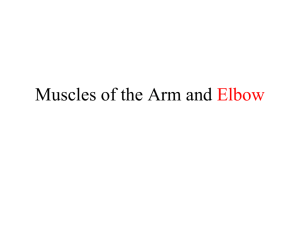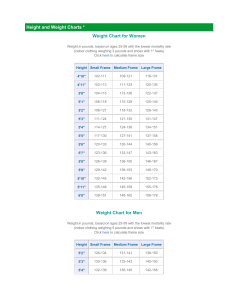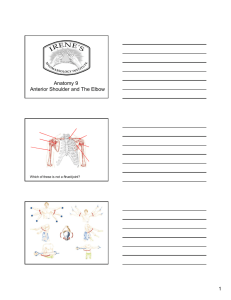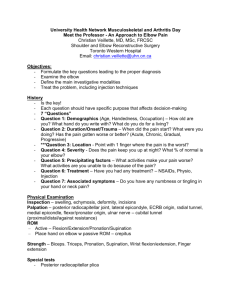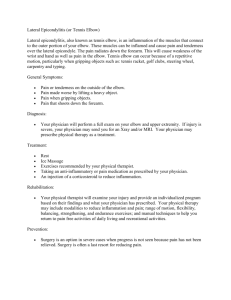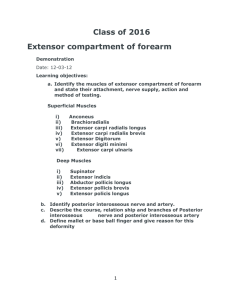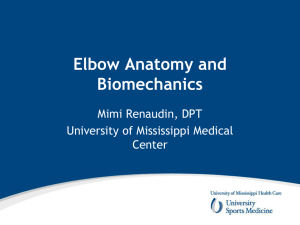PPT - The Citadel
advertisement
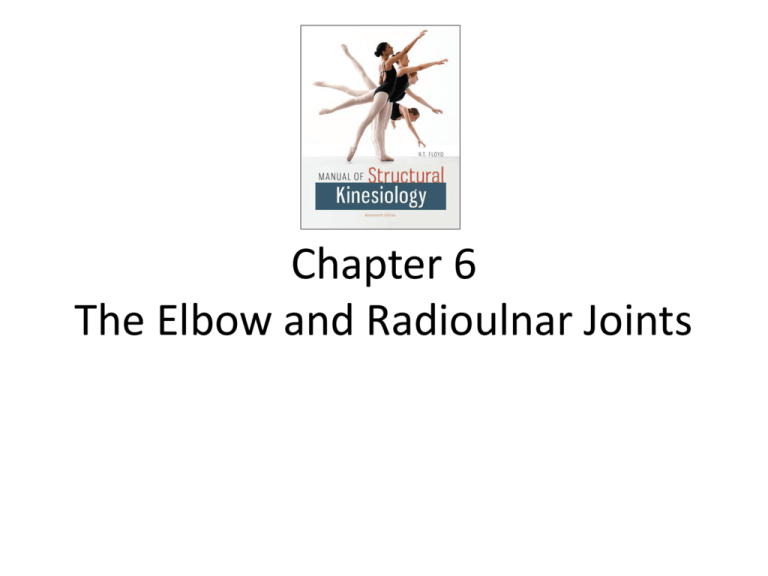
Chapter 6 The Elbow and Radioulnar Joints 6-1 The Elbow & Radioulnar Joints • Most upper extremity movements involve the elbow & radioulnar joints • Usually grouped together due to close anatomical relationship • Elbow joint movements may be clearly distinguished from those of the radioulnar joints • Radioulnar joint movements may be distinguished from those of the wrist 6-2 Bones • Ulna is much larger proximally than radius • Radius is much larger distally than ulna • Scapula & humerus serve as proximal attachments for muscles that flex & extend the elbow • Ulna & radius serve as distal attachments for these same muscles 6-3 Bones • Scapula, humerus, & ulna serve as proximal attachments for muscles that pronate & supinate the radioulnar joints • Distal attachments of radioulnar joint muscles are located on radius • Bony landmarks – medial condyloid ridge – olecranon process – coranoid process – radial tuberosity 6-4 Bones • Key bony landmarks for wrist & hand muscles – medial epicondyle – lateral epicondyle – lateral supracondylar ridge 6-5 Joints • Ginglymus or hinge-type joint • Allows only flexion & extension • 2 interrelated joints – humeroulnar joint – radiohumeral joints 6-6 Joints • Elbow motions – primarily involve movement between articular surfaces of humerus & ulna – specifically humeral trochlear fitting into ulna trochlear notch – radial head has a relatively small amount of contact with capitulum of humerus – As elbow reaches full extension, olecranon process is received by olecranon fossa • increased joint stability when fully extended 6-7 Joints • As elbow flexes 20 degrees or more, its bony stability is unlocked, allowing for more side-to-side laxity • Stability in flexion is more dependent on the lateral (radial collateral ligament) & the medial or (ulnar collateral ligament) 6-8 Joints • Ulnar collateral ligament is critical in providing medial support to prevent elbow from abducting when stressed in physical activity – Many contact sports & throwing activities place stress on medial aspect of joint, resulting in injury 6-9 Joints • Ulnar collateral ligament (UCL) – particularly crucial to high-velocity sporting activities requiring optimal medial elbow stability like baseball pitching – compromise of this structure often requires surgery – “Tommy John procedure” • UCL surgical reconstruction using a tendon graft such as palmaris longus tendon 6-10 Joints • Radial collateral ligament provides lateral stability & is rarely injured • Annular ligament provides a sling effect around radial head for stability 6-11 Joints • Elbow moves from 0 degrees of extension to 145 to 150 degrees of flexion 6-12 Joints • Carrying Angle – In anatomical position, it is common for forearm to deviate laterally from arm 5 to 15 degrees – Slightly greater in dominant limb than in non-dominant limb – Females commonly have a slightly greater carrying angle than men 6-13 Joints • Radioulnar joint – Trochoid or pivot-type joint – Radial head rotates around at proximal ulna – Distal radius rotates around distal ulna – Annular ligament maintains radial head in its joint 6-14 Joints • Radioulnar joint – Supinate 80 to 90 degrees from neutral – Pronate 70 to 90 degrees from neutral 6-15 Joints • Radioulnar joint – Joint between shafts of radius & ulna held tightly together between proximal & distal articulations by an interosseus membrane (syndesmosis) • substantial rotary motion between the bones 6-16 Joints • Synergy between glenohumeral, elbow, & radioulnar joint muscles – As the radioulnar joint goes through its ROM, glenohumeral & elbow muscles contract to stabilize or assist in the effectiveness of movement at the radioulnar joints – Ex. when tightening a screw with a screwdriver which involves radioulnar supination, we tend to externally rotate & flex the glenohumeral & elbow joints, respectfully 6-17 Joints • Synergy between glenohumeral, elbow, & radioulnar joint muscles – Conversely, when loosening a tight screw with pronation, we tend to internally rotate & extend the elbow & glenohumeral joints, respectfully – we depend on both the agonists and antagonists in the surrounding joints to assist in an appropriate amount of stabilization & assistance with the required task 6-18 Movements • Flexion – movement of forearm to shoulder by bending the elbow to decrease its angle • Extension – movement of forearm away from shoulder by straightening the elbow to increase its angle 6-19 Movements • Pronation – internal rotary movement of radius on ulna that results in hand moving from palm-up to palm-down position • Supination – external rotary movement of radius on ulna that results in hand moving from palmdown to palm-up position 6-20 Muscles • Elbow flexors – – – – Biceps brachii Brachialis Brachioradialis Weak assistance from Pronator teres • Elbow extensor – Triceps brachii – Anconeus provides assistance 6-21 Muscles • Radioulnar pronators – Pronator teres – Pronator quadratus – Brachioradialis • Radioulnar supinators – Biceps brachii – Supinator muscle – Brachioradialis 6-22 Muscles • “Tennis elbow" - common problem usually involving extensor digitorum muscle near its origin on lateral epicondyle – known as lateral epicondylitis or depending upon specific pathology may be termed lateral epicondylagia or lateral epicondylosis – associated with gripping & lifting activities • Medial epicondylitis – somewhat less common, known as golfer's elbow – associated with medial wrist flexor & pronator group near their origin on medial epicondyle – Both conditions involve muscles which cross elbow but act primarily on wrist & hand 6-23 Muscles • Anterior – Primarily flexion & pronation • • • • • Biceps brachii Brachialis Brachioradialis Pronator teres Pronator quadratus 6-24 Muscles • Posterior – Primarily extension & supination • Triceps brachii • Anconeus • Supinator 6-25 Nerves • All elbow & radioulnar joints muscles are innervated from median, musculotaneous, & radial nerves of brachial plexus 6-26 Nerves • Radial nerve - originates from C5, C6, C7, & C8 – Triceps brachii – Brachioradialis – Supinator (posterior interosseous nerve) – Anconeus – Sensation to posterolateral arm, forearm, & hand 6-27 Nerves • Median nerve - derived from C6 & C7 – Pronator teres – Pronator quadratus (anterior interosseus nerve) – Sensation to palmar aspect of hand & first three phalanges, palmar aspect of radial side of fourth finger, dorsal aspect of index & long fingers 6-28 Nerves • Musculotaneous nerve branches from C5 & C6 – Biceps brachii – Brachialis 6-29 Biceps Brachii Muscle Flexion of elbow Supination of forearm Weak flexion of shoulder joint Weak abduction of shoulder joint when externally rotated 6-30 Brachialis Muscle True flexion of elbow 6-31 Brachioradialis Muscle Flexion of elbow Pronation from supinated position to neutral Supination from pronated position to neutral 6-32 Triceps Brachii Muscle All heads: extension of elbow Long head: extension of shoulder joint; adduction of shoulder joint; horizontal abduction 6-33 Anconeus Muscle Extension of elbow 6-34 Pronator Teres Muscle Pronation of forearm Weak flexion of elbow 6-35 Pronator Quadratus Muscle Pronation of forearm 6-36 Supinator Muscle Supination of forearm 6-37 Elbow Flexion • Ex. Biceps curl • Agonists – Biceps brachii – Brachialis – Brachioradialis 6-38 Elbow Extension • EX. Push-up • Agonists – Triceps brachii • Anconeus 6-39 Radioulnar Pronation • Agonists – Pronator teres – Pronator quadratus – Brachioradialis 6-40 Radioulnar Supination • Ex. Tightening a screw • Agonists – Biceps brachii – Supinator muscle – Brachioradialis 6-41 Web Sites American Sports Medicine Institute www.asmi.org/bioEval.php?page=bio_eval – Pitching Biomechanics Evaluation University of Washington School of Medicine www.orthop.washington.edu/PatientCare/OurServices/ShoulderElbow.as px – Information on various upper extremity conditions Medical Multimedia Group www.eorthopod.com/adult-elbow-patient-guides – Elbow Patient Guides Huei Ming Chai www.pt.ntu.edu.tw/hmchai/Kines04/KINupper/Elbow.htm – Functions, stability and joint structure of elbow complex; kinematics, muscle action and common injuries of the elbow Southern California Orthopedic Institute www.scoi.com/teniselb.htm – Tennis elbow information . 6-42 Web Sites The Physician and Sportsmedicine www.physsportsmed.com/index.php?article=886 – Elbow injuries in young baseball players. American Family Physician www.aafp.org/afp/20000201/691.html – Evaluation of overuse elbow injuries. Loyola University Medical Center: Structure of the Human Body www.meddean.luc.edu/lumen/meded/grossanatomy/index.html – An excellent site with many slides, dissections, tutorials, etc., for the study of human anatomy. Wheeless’ Textbook of Orthopaedics www.wheelessonline.com – An extensive index of links to the fractures, joints, muscles, nerves, trauma, medications, medical topics, lab tests, and links to orthopaedic journals and other orthopaedic and medical news. 6-43 Web Sites Arthroscopy.com www.arthroscopy.com/sports.htm – Patient information on various musculoskeletal problems of the upper and lower extremities. The Physician and Sportsmedicine www.physsportsmed.com/index.php?article=1340 – Assessment and treatment guidelines for elbow injuries. National Aeronautics and Space Administration http://ihamedical.com/mesc/rehabworks/basicwristelbow.html – Basic Wrist and Elbow Rehabilitation 6-44
